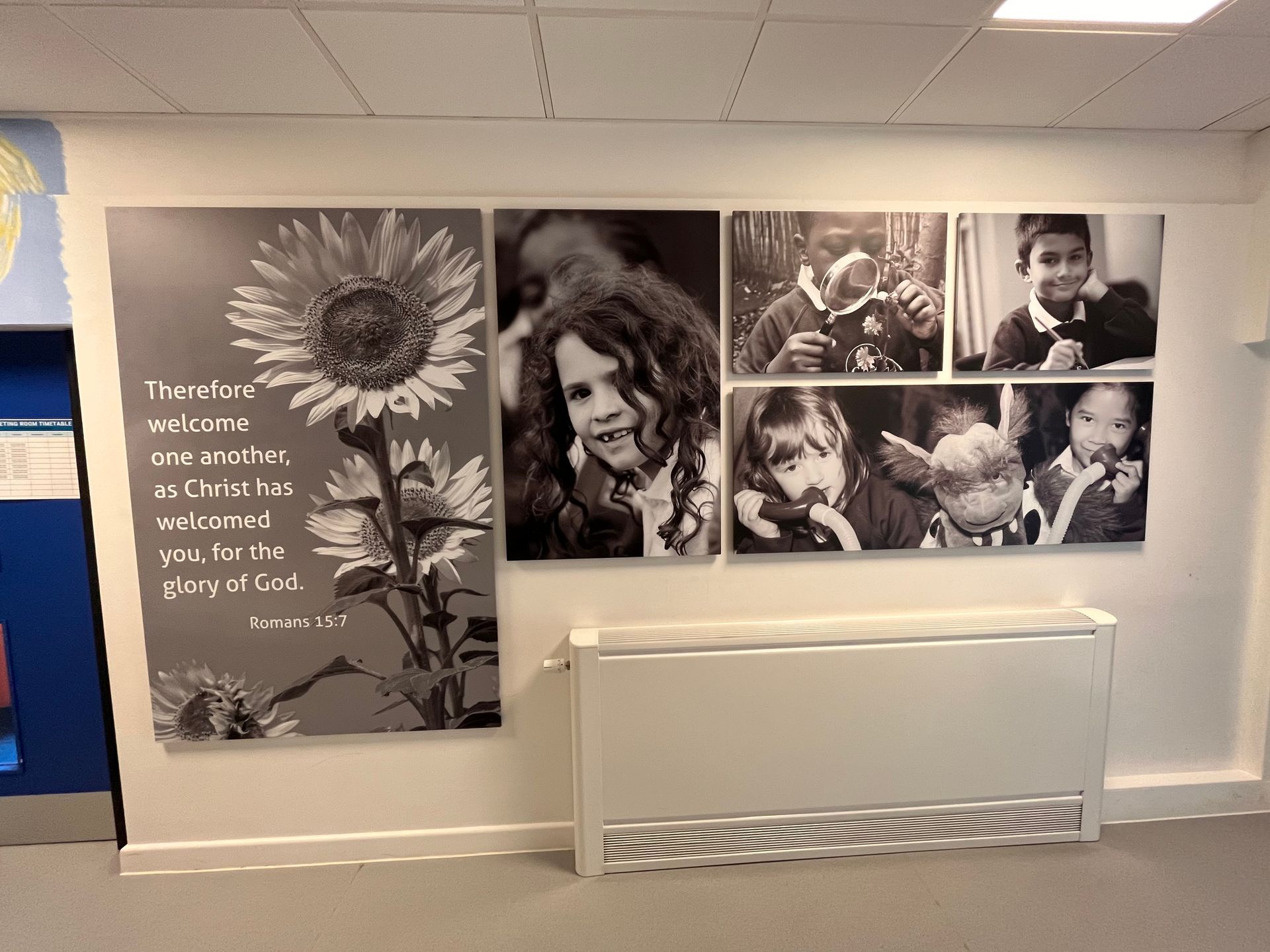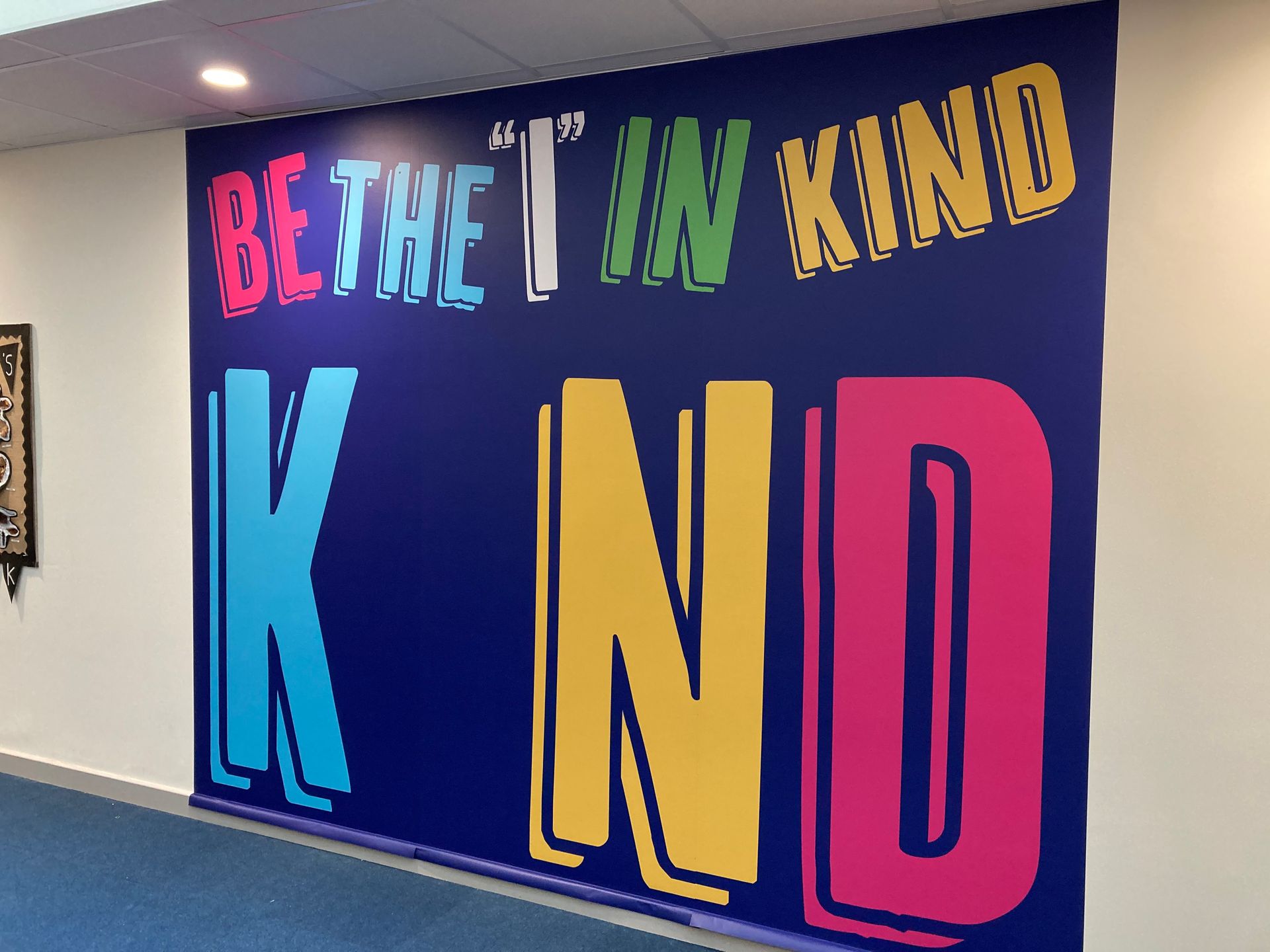Looking for other items, visit CUBED GROUP
Impact on schools-29
Using wall graphics to share the school's story can provide visitors, students and staff with an insight into the school's values, history and accomplishments. Here is a guide on how to create and incorporate wall graphics that effectively convey the school narrative;

Critical Components of Narrative Wall Graphics
1. Historical Timeline;
- Foundation and Milestones: Develop a timeline that showcases the school's establishment, essential milestones, key events and notable achievements.
- Balancing Visuals and Text: Use a combination of images, symbols, and concise text to maintain an informative timeline.
2. Accomplishments and Recognitions;
- Academic Excellence: Feature accomplishments, awards received, and recognition for both students and faculty members.
- Sports Achievements: Highlight victories in sports competitions, club activities, success stories, and other achievements in pursuits.
3. Community Engagement and Cultural Representation;
- Inclusive Portrayal: Incorporate elements and anecdotes that celebrate the diversity and inclusivity within the school community.Cultural Celebrations: visuals that honour festivities, traditions and events celebrated within the school.
Noteworthy Graduates;
- Achievement Stories: Showcase accomplished alumni and their successes, demonstrating how the school has contributed to their achievements.
- Motivational Quotes: This section features quotes from alums reflecting on their experiences at the school and how they influenced their paths.

Strategic Placement for Storytelling
1. Entrance and Lobby Areas:
- Welcome Narrative: Start the story at the entrance with a welcoming mural introducing the school’s history and core values.
- Digital Displays: Use digital screens to showcase dynamic content such as historical videos, interviews with alums, and virtual tours.
2. Hallways and Corridors:
- Themed Hallways: Design hallways with different themes, such as “Our History,” “Academic Excellence,” and “Community Spirit,” each telling a part of the school’s story.
- Interactive Timelines: Include interactive elements like touchscreens or QR codes that link to more detailed stories, videos, and documents.
3. Classrooms and Learning Areas:
- Subject-Specific Narratives: Use graphics in classrooms that highlight the history and development of the subject, significant discoveries, and contributions by notable figures in the field.
- Interactive Learning Walls: Create walls where students can add their contributions, such as historical facts they’ve researched or projects they’ve completed.
4. Common Areas and Cafeterias:
- Community Walls: Dedicate space for a “Wall of Fame” featuring student achievements, community service projects, and other contributions to the school’s culture.
- Celebration Murals: Use vibrant graphics to celebrate annual events, festivals, and school traditions.
Implementation Strategy
1. Collaborative Design Process:
- Stakeholder Involvement: Involve students, teachers, staff, and alums in the design process to gather various stories and perspectives.
- Professional Designers: Work with experienced designers to create high-quality, cohesive graphics that effectively tell the school’s story.
2. Material Selection:
- Durable and Sustainable: Choose durable and environmentally friendly materials to ensure the graphics last and align with sustainability values.
- Safety Compliance: Ensure all materials used are non-toxic and comply with safety standards.
3. Professional Installation:
- Expert Installation: Use professional installers to ensure the graphics are applied smoothly and correctly, avoiding any issues with alignment or damage.
- Seamless Integration: Ensure the graphics seamlessly integrate with the school's architecture and decor.
4. Maintenance and Updates:
- Regular Maintenance: Schedule regular maintenance to keep the graphics fresh and vibrant.
- Content Updates: Plan for periodic updates to keep the content current and reflect new achievements and changes in the school’s story.
Examples of Narrative Wall Graphics
1. Historical Timeline:
- Design: A detailed timeline highlighting key events in the school’s history, including founding dates, significant achievements, and notable alums.
- Impact: Provides visitors and students a comprehensive understanding of the school’s heritage and evolution.
2. Achievement Showcase:
- Design: A wall showcasing academic, sports, and extracurricular achievements, using a mix of photos, trophies, and descriptive text.
- Impact: Celebrates the successes of students and staff, inspiring pride and motivation.
3. Alumni Stories:
- Design: Feature stories of notable alums, including their photos, career highlights, and quotes about their time at the school.
- Impact: This section illustrates the long-term impact of the school on its students, inspiring current students with real-life success stories.
4. Cultural Celebration Wall:
- Design: Graphics that celebrate the school community's diverse cultural traditions and events, using vibrant images and descriptions.
- Impact: Fosters a sense of inclusivity and respect for diversity, making all students feel valued and represented.
Final Thoughts
By using wall graphics to tell the story of the school, its history, achievements, and community, schools can create a rich and engaging environment that educates and inspires. These graphics serve as a constant reminder of the school’s values and successes, fostering a strong sense of pride and belonging among students, staff, and visitors. This approach not only enhances the school's visual appeal but also deepens everyone's connection with the school’s unique narrative and culture.











